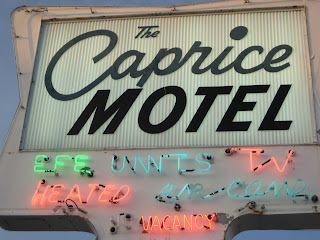
I'd heard of Wildwood my whole life - it's a popular resort and to my ears as a child, it sounded downright dangerous (I envisioned it to be like Boy's Town in the Disney version of Pinocchio). But after I had read about the great "Doo Wop Architecture" Wildwood had to offer in a New York Times article some time ago, my interest was piqued.

Its signage is great, particularly to me, since I wrote my thesis on roadside vernacular architecture and the way the automobile influenced the way buildings are designed.

From Business Week Online:
Doo Wop Motels, Wildwood, N.J. — Named after a popular 1950s singing style, Wildwood's Doo Wop motels are colorful beach resorts that line 40 blocks of New Jersey shoreline. Considered the largest collection of mid-20th century commercial resort architecture in the nation, the motels are famous for their neon-bright colors, funky signage, and exotic architecture of saw-toothed angles, crazy overhangs and space-age "Jetson" ramps. More than 100 of these iconic reminders of the recent past have already met the wrecking ball, and more are slated for demolition.

It's great stuff. It all reminds me of a set from a Quentin Tarantino movie. Desolate and dated, but with a sad sense of failed optimism.

The beach itself, as you can see below, is huge. It must be a quarter of a mile wide, and is clearly incomplete without the monster truck course that you can see in the bottom left of the photo.






































